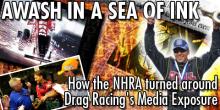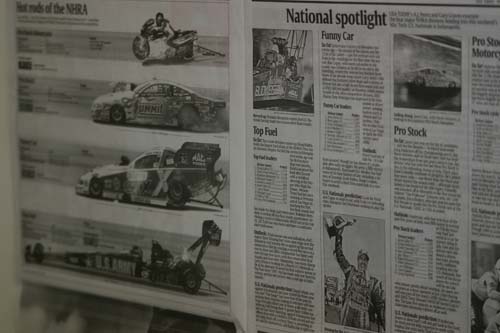AWASH IN A SEA OF INK
 Drag racing is a hard sell to much of the so-called “straight press,”
and it’s with considerable irony that we point out the reason for some
of the sport’s difficulties in this area rest with – the press
itself. Forty years ago it wasn’t uncommon for a major metropolitan
daily’s second section to be headlined, “Speeding Drag Racer Loses
Control: 2 Die In Fiery Crash.” With slight alteration that same
headline could have appeared 20 years ago, 10 years ago or even last
week – and in some city, somewhere, probably did.
Drag racing is a hard sell to much of the so-called “straight press,”
and it’s with considerable irony that we point out the reason for some
of the sport’s difficulties in this area rest with – the press
itself. Forty years ago it wasn’t uncommon for a major metropolitan
daily’s second section to be headlined, “Speeding Drag Racer Loses
Control: 2 Die In Fiery Crash.” With slight alteration that same
headline could have appeared 20 years ago, 10 years ago or even last
week – and in some city, somewhere, probably did.For decades the NHRA’s myriad public relations managers fought a losing battle in trying to convince the press that an alcohol-fueled teenager killed in an illegal speed contest was not, in fact, a “drag racer,” nor was that “stoplight Grand Prix” even a drag race. It’s nothing short of amazing how an activity as basic as drag racing can so often be misidentified or inaccurately defined. Watch any NASCAR race and the announcers – who should know better – consistently state “It’s a drag race to the first corner,” when in actuality, nothing could be further from the truth.


For decades the NHRA’s myriad public relations managers fought a losing battle in trying to convince the press that an alcohol-fueled teenager killed in an illegal speed contest was not, in fact, a “drag racer,” nor was that “stoplight Grand Prix” even a drag race. It’s nothing short of amazing how an activity as basic as drag racing can so often be misidentified or inaccurately defined. Watch any NASCAR race and the announcers – who should know better – consistently state “It’s a drag race to the first corner,” when in actuality, nothing could be further from the truth.
While it was easy to blame the so-called straight press for drag racing’s minimal and usually negative exposure, the other easy target was the NHRA Media Department. From the Super Street racer who won 10 local races in a row and never saw his name mentioned in the paper to the seasoned pro who had the same gripe, blaming NHRA for the dearth of publicity was no more complicated than opening one’s mouth and shouting it to the stars. As tempting as that might have been, to do so was often to do an injustice to those who, despite their often middling successes, were trying their best.
Just as the NHRA and literally hundreds of just plain folks tried to convince their local news and/or sports editor that accidents on the street weren’t really drag racing, they faced the same hurdles in trying to convince those same individuals that the quarter-mile sport was worthy of exposure in their hallowed publications.
a d v e r t i s e m e n t
Click to visit our sponsor's website

So, due to numerous reasons the sport continued to be a difficult “sell” for decades. The arrival of Winston as NHRA’s series sponsor (after, it should be noted, they provided similar sponsorship to IHRA), certainly helped bring about some changes, as even the most intransigent editor realized that a company the size of R.J. Reynolds wouldn’t be involved with thugs and criminals regardless of their potential buying power. And, NHRA’s Media Department was also maturing, a point made clear to many long-term drag racing photojournalists who suddenly found themselves being figuratively trampled by an NHRA employee who thought he’d spotted someone from Sports Illustrated or the Los Angeles Times.
While all of this was going on another factor came into play, and that was the increasing professionalism of the race teams, many of whom had taken the then-bold step of hiring paid public relations people to state their case and keep their names in front of the media. Certainly some of those early efforts were crude and ineffectual, but as the racers matured, so did their public relations efforts.
Kenny Bernstein set the bar when he hired Susan Arnold to handle his promotional efforts, and she delivered like no one else ever had. Simplistically, early on Bernstein went months without qualifying his Budweiser-backed Funny Car in national event competition, but all the while Ms. Arnold was successfully placing stories on her driver in virtually every newspaper she could reach. When Bernstein made an appearance at a distributorship – and there were dozens of those during his early years with Bud – she got a story “placed” in the local paper to go with it.
When Bernstein switched to Top Fuel and broke the 300 MPH barrier, Arnold blitzed the national media with photos and stories of the accomplishment. Her efforts were, in every sense of the word, far more successful than anything the NHRA of 1992 was capable of orchestrating. (Never to be forgotten: Newsweek’s “motorsports editor,” a woman with absolutely no knowledge of racing, telling Arnold that “We might be interested if he’d’ve run 300 MPH at the Indy 500, but that’s all!” And you wondered why it’s been so difficult getting the sport exposure!)
a d v e r t i s e m e n t
| {flashembed}swf=/images/banners/flashBanner/ramad1.swf|w=468|h=60{/flashembed} |
Click to visit our sponsor's website

But, as important as these individual campaigns have been, even more praise has to be aimed at NHRA’s own programs, because behind the scenes their non-stop efforts at promoting both individual drivers and the sport itself has slowly but surely begun paying significant dividends. In 2006 they scored as never before, obtaining exceptional exposure for the sport in a wide variety of formerly “closed” outlets.
How was this accomplished? Through non-stop efforts that ignored unreturned phone calls, and fought back against the negativism the sport has faced for decades. It certainly helped that charismatic competitors like Melanie Troxel set the sport afire during the first half of 2006, but no matter how many races in which she appeared in the final rounds, someone still had to “sell” her to the media, and that task was ably handled by both the team and the NHRA Media Department. It’s also worth including here that Ms. Troxel’s marriage to Funny Car driver Tommy Johnson, Jr. might have made team involvement in her promotion somewhat problematic, but NHRA faced no such difficulties.
Largely through the efforts of Anthony Vestal, director of media relations, accomplishments like Troxel’s didn’t go unrecognized. Appearances on CBS Sunday Morning and ESPN’s Cold Pizza, along with a very positive piece in Sports Illustrated (that included TJ, Jr.) were just a few of the media victories the NHRA attained in ’06.
a d v e r t i s e m e n t
Click to visit our sponsor's website

Every time a member of the media brought this up to an NHRA official – and it was often – the response was that drag racing had never made an effort to formally incorporate either minorities or women because they’d been welcomed and part of the show since the first tire turned on asphalt. Most media reps were surprised to hear that, forcing the Media Department to trot out their long list of successful women competitors, from Amy Faulk to Shirley Muldowney to Hillary Will ad infinitum. When the “minority” question was asked they had to recall names like John Kimball, the Pedregons and this year’s fast-rising superstar, J.R. Todd. And a funny thing happened on the way to Enlightment Land: No minority participant in NHRA drag racing had ever seen the need to highlight his or her ethnicity, and certainly, neither had the sanctioning organization.
Since the NHRA telecasts began calling the ESPN channels home one thing has remained more or less constant – the network’s almost total lack of promotion on behalf of that programming. Here again the NHRA Media Department worked hard to overcome this lack of promotion, and scored significant successes during the season. Most importantly, but certainly beyond the purview of the general public, the arrival of a new public relations person at ESPN coincided with the culmination of this year’s remarkable points chase. Since then the network has been circulating a number of press releases touting the NHRA POWERade Series. While those don’t impact many of us, they do help in very important ways, because, for example, if a newspaper writer watches an exciting race he could be “convinced” to do a feature story on one of the participants when the circus hits his home track next year.
Even the horrific has helped generate significant exposure this year. Cory McClenathan’s breath-stopping crash at Bristol made every highlight reel in ESPN’s library. Just as importantly, McClenathan’s on-track misfortune was also picked up by dozens, if not hundreds, of local TV stations. Anyone who doubts the “importance” of that incident apparently didn’t tune in to The Paula Zahn Show news magazine program on CNN the following Tuesday, when the crash was re-played and McClenathan was interviewed. The footage may have been frightening to his fellow racers, but to the unwashed out there seeing a drag race for the first time, it was Academy Award-quality stuff, and so was McClenathan’s interview, during which he appeared composed and professional. No offense intended, but it’s difficult to imagine the likes of John “Tarzan” Austin, “Jungle” Jim Liberman or Omar “The Tentmaker” Carruthers handling themselves as professionally in their heyday.
a d v e r t i s e m e n t
Click to visit our sponsor's website

How far has drag racing come? The Sports Illustrated issue that came out in conjunction with the Finals carried information and a photo of Tony Schumacher’s car in their “What To Watch” section. No matter that the photo was the size of a postage stamp. The mere fact that it was the only photo in the section, and the mere fact that it was about drag racing, was enlightening. Five years ago you wouldn’t have seen a story on drag racing in SI even if it included murder and mayhem.
NHRA’s Media Department may be a convenient target for the ire of racers who’ve failed to deliver significant, or even any, exposure for their sponsors, but their disappointment is being aimed in the wrong direction. Some of those who’ve complained the loudest should probably look a little inward.
If your car can’t qualify, or can’t the run the numbers, or can’t win, who’s at fault for your lack of exposure? If you’re uncooperative when the media does come calling, and no story results, who’s at fault? If you rebuff NHRA’s requests to participate in media affairs, who’s at fault? We’re not defending the NHRA Media Department, we’re only pointing out the obvious. Sometimes the racers themselves are responsible for their lack of exposure. Sometimes, but not always.
There’s certainly room for improvement when it comes to generating exposure for drag racing, and that will always be the case. Some more experienced promotional people might be a welcome addition to the NHRA efforts. But the bottom line is simply this: In 2006 NHRA did their best job ever in promoting the sport and its stars.
Now, let’s see what they can do to improve on that in 2007!
| {loadposition feedback} |





